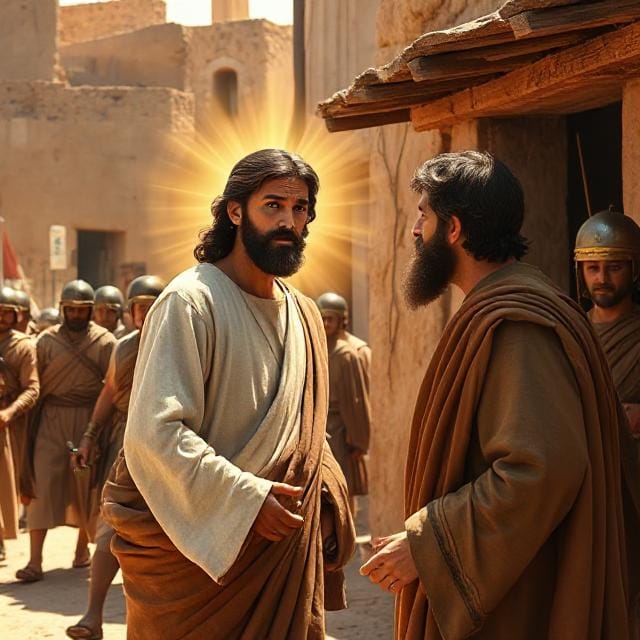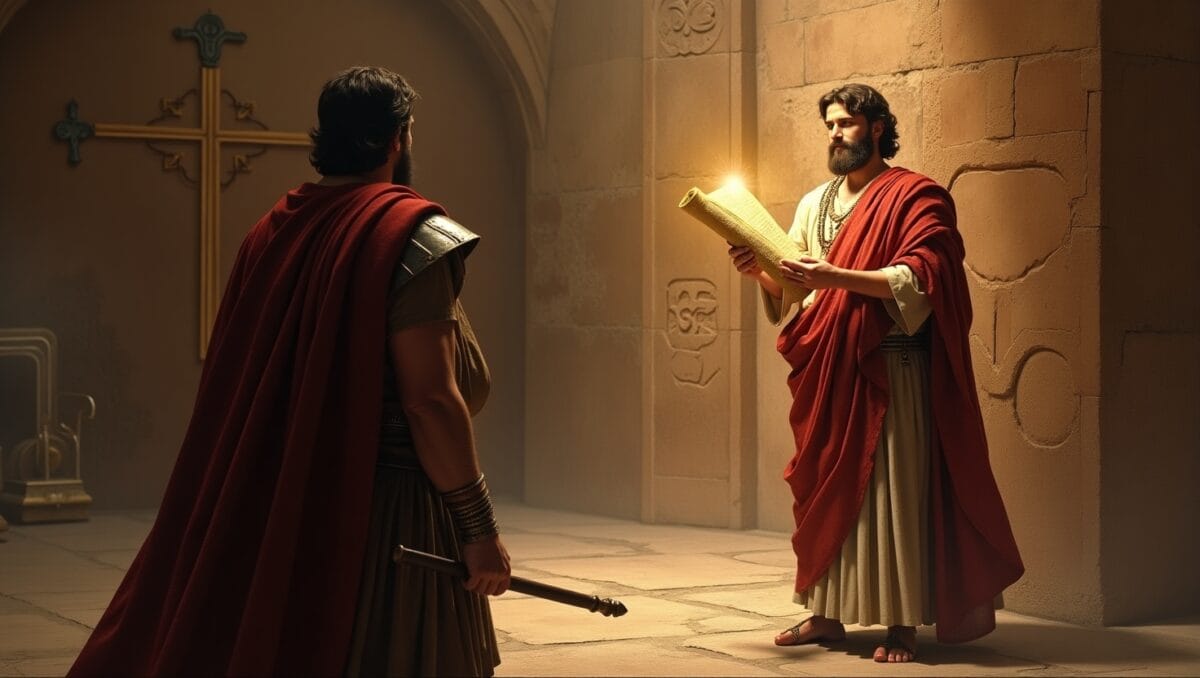Matthew the Apostle: From Roman Tax Collector to Apostle of Christ – A Powerful Story of Redemption and Faith

Table of Contents
Introduction: The Unlikely Disciple
Life Before Christ: The Tax Collector’s World
The Calling: Jesus Says “Follow Me”
Transformation from Levi to Matthew
Behind the Gospel of Matthew: Writer and Theologian
Prophecy Fulfilled: Jesus Through Jewish Eyes
Matthew’s Writings: Love, Mercy, and the Nature of Christ
Lesser-Known Facts About Matthew’s Life
Matthew’s Missionary Journey: Beyond Judea
The Martyrdom of Matthew: Faith Unto Death
Legacy and Modern Relevance
Conclusion: The Apostle Who Showed the World Jesus as Messiah
Introduction: The Unlikely Disciple
In the annals of Christian history, few stories are as compelling as that of Matthew the Apostle.
Known also as Levi, Matthew was a tax collector in Capernaum—a profession that made him a social outcast in Jewish society. Tax collectors were often seen as corrupt and traitorous, working with the occupying Roman Empire.
Yet, this unlikely figure was personally called by Jesus Christ to become one of His twelve apostles. It was a moment of divine grace that turned a man of worldly gain into a messenger of eternal truth.
Matthew is traditionally credited with authoring the Gospel of Matthew, a cornerstone of the New Testament. His writings emphasize Jesus as the Messiah foretold in Jewish scriptures, beautifully bridging Old Testament prophecy with New Testament fulfillment.
His journey—from a life of moral compromise to one of divine purpose—is a powerful testament to the transformative power of faith.
This biography explores Matthew’s life: from his early work as a tax collector to his missionary efforts, possible martyrdom, and his enduring spiritual legacy.
It offers inspiration to spiritual seekers, Christian scholars, and curious minds alike.
✨ For more explorations into the Scriptures and insights on God’s divine plan, visit our Bible blog filled with faith-inspired articles.
Life Before Christ: The Tax Collector’s World
The Role of Tax Collectors in Ancient Judea
In the first century, Judea was under Roman occupation, and tax collectors, or publicans, were integral to the Roman economic system. Matthew the Apostle, then known as Levi, worked in Capernaum, a thriving trade hub on the Sea of Galilee. Tax collectors were responsible for collecting duties on goods, such as imports, exports, and fishing tolls, often for local rulers like Herod Antipas, who operated under Roman authority. The system allowed tax collectors to charge more than the required amount, keeping the excess as profit, which led to widespread corruption (Jewish Encyclopedia).
Social Stigma and Ostracism
Tax collectors were deeply despised in Jewish society for several reasons:
Collaboration with Rome: They were seen as traitors, working for the oppressive Roman Empire and its proxies, betraying their own people.
Corruption: Many tax collectors exploited their authority, overcharging taxpayers to enrich themselves, as noted in historical accounts (Watchtower).
Religious Impurity: The Pharisees and other religious leaders classified tax collectors as sinners, barring them from synagogues and religious life. The Babylonian Talmud equated them with “murderers and robbers” (Baba Qama 113a, Evidence Unseen).
Social Exclusion: They were disqualified as witnesses in court, excommunicated from religious communities, and considered a disgrace to their families (Bible Study Tools).
Matthew’s life as a tax collector placed him on the fringes of society, wealthy but isolated, living in a world of moral compromise and public scorn.
Capernaum: The Setting of Matthew’s Life
Capernaum, where Matthew the Apostle worked, was a bustling center of commerce and culture, strategically located along trade routes. Its diverse population included Jews, Gentiles, and Roman officials, making it a microcosm of the tensions between Roman rule and Jewish identity. Matthew’s tax booth, likely near the harbor, was a visible symbol of Roman oppression, reinforcing his status as an outcast. Yet, it was in this unlikely setting that Jesus would find and call him.
The Calling: Jesus Says “Follow Me”
A Divine Encounter
The pivotal moment in Matthew’s life is recorded in the Synoptic Gospels: “As Jesus went on from there, he saw a man named Matthew sitting at the tax collector’s booth. ‘Follow me,’ he told him, and Matthew the Apostle got up and followed him” (Matthew 9:9, NIV). Similar accounts in Mark 2:14 and Luke 5:27-28 refer to him as Levi, confirming that Matthew and Levi are the same person due to the identical context and language (GotQuestions).
This simple yet profound call was revolutionary. Jesus, a rabbi and teacher, chose a tax collector—an outcast and sinner—as a disciple, defying social and religious norms. Matthew’s immediate response, leaving his tax booth without hesitation, reflects a deep conviction and readiness to embrace a new life. The economic and social cost was significant, as tax collecting was lucrative, but Matthew chose faith over wealth.
The Feast with Sinners
Following his calling, Matthew hosted a feast for Jesus, inviting other tax collectors and sinners (Matthew 9:10-13). This act drew criticism from the Pharisees, who questioned why Jesus associated with such people. Jesus’ response—“It is not the healthy who need a doctor, but the sick. But go and learn what this means: ‘I desire mercy, not sacrifice.’ For I have not come to call the righteous, but sinners” (Matthew 9:12-13)—underscored His mission of redemption and inclusion. Matthew the Apostle inclusion in this circle marked the beginning of his transformation and his role as a bridge between Jesus and society’s outcasts.
Transformation from Levi to Matthew
A New Name, A New Identity
The transition from Levi to Matthew is significant. The name “Matthew the Apostle,” meaning “gift of God” in Hebrew, may have been bestowed by Jesus, a common practice among disciples (e.g., Simon becoming Peter). This name change symbolized Matthew’s new identity and purpose as a follower of Christ (Catholic Encyclopedia). From a tax collector associated with greed and betrayal, he became an apostle dedicated to spreading the Gospel.
Symbol of Redemption
Matthew the Apostle transformation is a powerful narrative of redemption. His willingness to abandon his old life illustrates the radical change that faith in Jesus can bring. As a tax collector, he was an unlikely candidate for discipleship, yet Jesus saw potential in him. This story resonates with the Christian belief that no one is beyond God’s grace, and it sets the stage for Matthew the Apostle later contributions as a writer and missionary.
Behind the Gospel of Matthew: Writer and Theologian

Authorship and Tradition
Matthew the Apostle is traditionally credited with authoring the Gospel of Matthew, the first of the four canonical Gospels in the New Testament. Early Church Fathers, such as Irenaeus and Clement of Alexandria, affirmed this attribution, stating that Matthew wrote the Gospel in Hebrew or Aramaic for Jewish Christians before it was translated into Greek (Catholic Answers). The Church’s universal agreement, supported by ancient codices, versions of the Bible, and liturgical usage, reinforces this view.
However, modern biblical scholars often question this authorship, suggesting that the Gospel was written in the late first century by an anonymous Jewish Christian familiar with legal aspects of scripture, possibly using Mark’s Gospel and other sources (Wikipedia: Gospel of Matthew). Despite this debate, the traditional view remains significant for Christian audiences, and this biography adopts that perspective while acknowledging scholarly discussions.
✨ For more explorations into the Scriptures and insights on God’s divine plan, visit our Bible blog filled with faith-inspired articles.
Purpose and Audience
The Gospel of Matthew was written primarily for a Jewish audience, aiming to demonstrate that Jesus is the Messiah foretold in the Old Testament. Its structure and content reflect this purpose:
Genealogy: It begins with a detailed genealogy tracing Jesus’ lineage to Abraham and David, establishing His Messianic credentials (Matthew 1:1-17).
Prophetic Fulfillment: Matthew frequently cites Old Testament prophecies, using phrases like “it is written” to connect Jesus’ life to scripture.
Jewish Context: The Gospel uses polished Semitic Greek and addresses Jewish customs and concerns, such as debates with Pharisees and scribes (Wikipedia: Gospel of Matthew).
Structure and Content
The Gospel is organized around five major discourses, often seen as paralleling the five books of the Torah, reinforcing its Jewish focus. These include the Sermon on the Mount (chapters 5-7), the Missionary Discourse (chapter 10), and the Olivet Discourse (chapters 24-25). It also contains unique elements like the infancy narrative, detailing Jesus’ birth and early life, and parables not found in other Gospels (Britannica: Gospel According to Matthew).
Matthew’s background as a tax collector, likely requiring literacy in Aramaic and Greek, equipped him to record Jesus’ teachings accurately. His Gospel became a cornerstone of the New Testament, shaping early Christian theology and practice.
Prophecy Fulfilled: Jesus Through Jewish Eyes
Emphasis on Old Testament Prophecies
A hallmark of Matthew’s Gospel is its emphasis on Jesus as the fulfillment of Old Testament prophecies. Matthew meticulously connects Jesus’ life to scriptural predictions, reinforcing His identity as the Messiah. Examples include:
Virgin Birth: “All this took place to fulfill what the Lord had said through the prophet: ‘The virgin will conceive and give birth to a son, and they will call him Immanuel’” (Matthew 1:22-23, citing Isaiah 7:14).
Bethlehem Birth: “This was to fulfill what was spoken through the prophet: ‘But you, Bethlehem, in the land of Judah… out of you will come a ruler who will shepherd my people Israel’” (Matthew 2:5-6, citing Micah 5:2).
Flight to Egypt: “And so was fulfilled what the Lord had said through the prophet: ‘Out of Egypt I called my son’” (Matthew 2:15, citing Hosea 11:1).
These citations, often introduced with “it is written,” were crucial for convincing Jewish readers of Jesus’ Messianic role (OverviewBible).
Bridging Old and New Testaments
Matthew’s Gospel serves as a bridge between the Old and New Testaments, showing continuity between Jewish tradition and Christian faith. His familiarity with Jewish scriptures, possibly honed during his time as a tax collector dealing with legal documents, allowed him to craft a narrative that resonated with Jewish Christians while also appealing to Gentiles. This dual focus helped establish Christianity as a universal faith rooted in Jewish heritage.
Matthew’s Writings: Love, Mercy, and the Nature of Christ
Key Teachings in the Gospel
Matthew’s Gospel reveals a Christ who is both divine and compassionate, emphasizing love, mercy, and inner purity. Key teachings include:
The Beatitudes: Found in the Sermon on the Mount, these blessings highlight virtues like humility, mercy, and peacemaking: “Blessed are the merciful, for they will be shown mercy” (Matthew 5:7).
The Lord’s Prayer: A model for prayer, emphasizing forgiveness and dependence on God: “Forgive us our debts, as we also have forgiven our debtors” (Matthew 6:12).
Parables: Stories like the Parable of the Sower (Matthew 13:1-23) and the Parable of the Talents (Matthew 25:14-30) illustrate spiritual truths about the Kingdom of Heaven.
The Golden Rule: “So in everything, do to others what you would have them do to you, for this sums up the Law and the Prophets” (Matthew 7:12).
Emphasis on Mercy and Inclusion
Matthew’s Gospel underscores Jesus’ outreach to sinners and outcasts, reflecting Matthew’s own experience as a tax collector. Jesus’ words, “I desire mercy, not sacrifice” (Matthew 9:13, citing Hosea 6:6), challenge religious legalism and highlight God’s desire for compassionate hearts. This message of inclusion and forgiveness became a cornerstone of Christian ethics, influencing how believers interact with others.
Theological Impact
Matthew’s portrayal of Jesus as both King and Servant shaped early Christian theology. His emphasis on the Kingdom of Heaven, mentioned over 30 times, underscores the spiritual and eternal nature of God’s reign (Watermark Waves). These teachings continue to guide Christian thought, encouraging believers to live lives of love, humility, and service.
Lesser-Known Facts About Matthew’s Life
Despite his prominence, much of Matthew’s life remains obscure. Here are some lesser-known facts that enrich his story:
Possible Brotherhood: Matthew may have been the brother of James, son of Alphaeus, as both are listed as sons of Alphaeus in the Gospels (Mark 2:14, Matthew 10:3, Wikipedia: Matthew the Apostle).
Symbolism in Art: In Christian iconography, Matthew is represented as a winged man, one of the four living creatures in Revelation 4:7, symbolizing his role as an evangelist (Newman Connection).
Feast Day: His feast day is celebrated on September 21 in the Western Church and November 16 in the Eastern Church, reflecting his universal veneration (Britannica: Saint Matthew).
Apocryphal Writings: Non-canonical texts, such as “De Ortu beatæ Mariæ et infantia Salvatoris,” are attributed to Matthew, though their authenticity is disputed (Catholic Encyclopedia).
Literacy and Skills: As a tax collector, Matthew was likely literate in Aramaic and Greek, skills that aided his role as a Gospel writer (Study.com).
These details, drawn from tradition and scripture, offer a fuller picture of Matthew’s life and contributions.
✨ For more explorations into the Scriptures and insights on God’s divine plan, visit our Bible blog filled with faith-inspired articles.
Matthew’s Missionary Journey: Beyond Judea
Preaching in Judea
After Jesus’ ascension, Matthew the Apostle is believed to have preached the Gospel first in Judea, targeting Jewish communities. Early Church Fathers like Irenaeus and Clement of Alexandria report that he spent several years evangelizing among the Hebrews, possibly for 15 years, before venturing elsewhere (Catholic Encyclopedia). His Gospel, written during this period, was a tool for converting Jews by connecting Jesus to Old Testament prophecies.
Missionary Work Abroad
Tradition holds that Matthew later traveled to other regions, though historical records are limited. Common destinations mentioned include:
Ethiopia: Many sources, including the Roman Martyrology, suggest Matthew preached in Ethiopia (possibly south of the Caspian Sea, not modern Ethiopia), where he established Christian communities (Young Catholics).
Persia and Parthia: Some accounts indicate he evangelized in Persia and among the Parthians, spreading the Gospel to Gentile populations (Answered Faith).
Syria and Macedonia: Less common traditions mention missionary work in Syria or Macedonia, though these are less substantiated.
While details are scarce, Matthew’s missionary efforts likely involved baptizing new believers, teaching Jesus’ message, and founding small Christian communities. His work helped expand Christianity beyond its Jewish roots, fulfilling Jesus’ command to “make disciples of all nations” (Matthew 28:19).
Challenges and Impact
Missionary work in the first century was fraught with challenges, including persecution, cultural barriers, and travel dangers. Matthew’s background as a tax collector, accustomed to dealing with diverse groups, may have aided his ability to connect with varied audiences. His efforts laid the groundwork for the global spread of Christianity, demonstrating the universal scope of Jesus’ message.
The Martyrdom of Matthew: Faith Unto Death
Conflicting Traditions
The circumstances of Matthew’s death are uncertain, with various traditions offering different accounts:
Martyrdom in Ethiopia: The Roman Martyrology states that Matthew was martyred in Ethiopia, possibly by stabbing or burning, while preaching the Gospel (Catholic Encyclopedia). Foxe’s Book of Martyrs claims he was slain with a halberd in Nabadar (Learn Religions).
Other Accounts: Some sources, like Heracleon (cited by Clement of Alexandria), suggest Matthew died of natural causes, though this conflicts with most traditions (OverviewBible).
Alternative Locations: Less common accounts place his martyrdom in Persia or Parthia, with methods like beheading or stoning.
The lack of definitive historical evidence reflects the challenges of documenting early Christian martyrs. However, the prevailing tradition of martyrdom in Ethiopia underscores Matthew’s commitment to his faith.
Significance of Martyrdom
Whether Matthew was martyred or died naturally, his life’s end symbolizes his unwavering dedication to Christ. Martyrdom, in early Christianity, was seen as the ultimate act of faith, a testimony to the truth of the Gospel. Matthew’s willingness to face persecution and possibly death reflects the courage of the apostles, who spread Christianity despite immense risks.
Legacy and Modern Relevance
The Enduring Impact of Matthew’s Gospel

Matthew’s Gospel is one of the most influential texts in Christianity, shaping theology, ethics, and practice for over two millennia. Its key contributions include:
Theological Foundation: The Gospel establishes Jesus as the Messiah and King, providing a framework for understanding His divine and human nature.
Ethical Teachings: The Sermon on the Mount, including the Beatitudes and the Lord’s Prayer, offers timeless guidance on Christian living, emphasizing humility, mercy, and love (Christianity.com).
Missionary Mandate: The Great Commission—“Therefore go and make disciples of all nations, baptizing them in the name of the Father and of the Son and of the Holy Spirit” (Matthew 28:19-20)—has inspired countless missionary efforts, from the early Church to modern times.
The Gospel’s emphasis on Jesus’ fulfillment of prophecy also helped legitimize Christianity among Jewish converts, facilitating its spread in the first century.
A Model of Transformation
Matthew’s journey from a despised tax collector to a revered apostle is a powerful narrative of redemption. His story resonates with modern Christians, illustrating that faith can transform even the most unlikely individuals. His inclusion among the apostles challenges societal judgments, showing that God’s call transcends human prejudice.
Modern Applications
In today’s world, Matthew’s teachings remain relevant:
Social Inclusion: His association with sinners and outcasts encourages Christians to embrace marginalized groups, reflecting Jesus’ inclusive love.
Ethical Living: The Beatitudes and other teachings provide a moral compass for navigating contemporary challenges, promoting peace, justice, and compassion.
Missionary Zeal: The Great Commission inspires ongoing evangelistic efforts, from local outreach to global missions, encouraging believers to share their faith (Facts.net).
Matthew’s life and writings continue to inspire spiritual growth, reminding believers of the transformative power of faith and the universal call to discipleship.
Conclusion: The Apostle Who Showed the World Jesus as Messiah
Matthew the Apostle’s life is a remarkable story of divine calling and eternal impact.
From his early days as Levi, a tax collector shunned by his own people, he was seen as a symbol of corruption and compromise. Yet, Jesus saw potential and purpose in him.
When Jesus called him, Matthew left everything behind without hesitation. This moment marked the beginning of a transformed life—a life dedicated to truth, grace, and discipleship.
His Gospel stands as a masterful blend of Jewish tradition and Christian revelation. Through detailed genealogy, fulfilled prophecy, and powerful teachings, Matthew presented Jesus as the long-awaited Messiah.
More than a historical account, his Gospel is a testimony of love, mercy, and redemption. It reveals Christ not only as the fulfillment of ancient promises but also as the Savior for all.
Matthew’s missionary work helped spread the message of Jesus beyond Israel, possibly reaching Ethiopia or Persia. His dedication likely led to martyrdom, sealing his faith with ultimate sacrifice.
Today, his legacy endures in the hearts of believers around the world. His journey reminds us that no one is beyond God’s grace, and that each of us is invited to follow Christ with courage and devotion—just as Matthew did.
✨ For more explorations into the Scriptures and insights on God’s divine plan, visit our Bible blog filled with faith-inspired articles.
